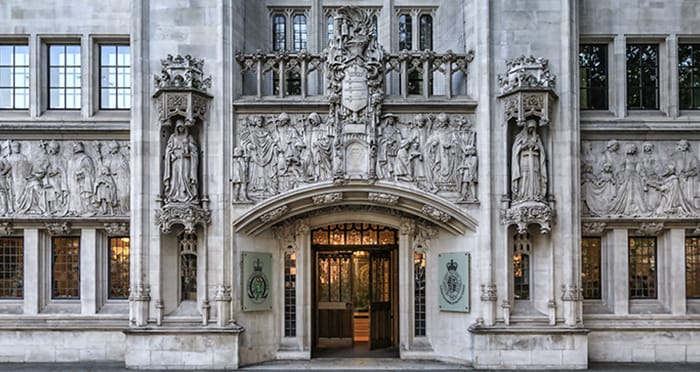Birmingham Uni law student Olivia Gladstone looks at the recent high-profile tort cases involving Morrisons and Barclays

On 1 April 2020, two cases came to the Supreme Court, WM Morrisons Supermarkets plc (Appellant) v Various Claimants (Respondent) and Barclays Bank plc (Appellant) v Various Claimants (Respondents), both of which sought to deal with the long-standing principle of vicarious liability.
What is vicarious liability?
Vicarious liability is when one party is liable for the wrongdoing of another party. An example of a relationship that would evoke this doctrine is an employment relationship; where an employee is at fault for a tortious wrong, the employer would be liable to pay the damages.
Two elements need to be fulfilled before vicarious liability will be successfully shown:
1. There must be a ‘relationship’ between the two people which makes it proper to make one pay for the fault of the other.
2. There must be a sufficient connection between that relationship and the wrongdoing of the person who committed the tort.
Case overviews
Barclays Bank v Various Claimants sought to tackle the first element of this criterion; when does such a ‘relationship’ arise for one to be vicariously liable for the other?
Barclays hired a doctor’s services to perform compulsory medical examinations on new employees. Years later, it was discovered that he had allegedly sexually assaulted 126 patients during the course of these examinations. The Supreme Court held that as the doctor was not strictly ‘employed’ by Barclays but was instead an ‘independent contractor’, Barclays was not liable for the doctor’s alleged wrongdoing.
Morrisons Supermarket v Various Claimants tackles the second element of the criterion; when is there a ‘sufficient connection’?
In a personal vendetta against the company, a Morrisons auditor leaked thousands of employees’ personal information online. These employees later brought this case against Morrisons. The Supreme Court held that as the auditor acted outside of his job description and for ‘purely personal reasons’ which had no economic benefit for Morrisons, there was not a sufficient connection between the wrongdoing and the employment relationship.
Within one day, the Supreme Court sought to address the ambiguity of vicarious liability. However, we can question: how successful has the court been?
The purpose of vicarious liability (much like the whole of tort law) is to secure compensation and justice for victims via payment of damages. Have these new decisions tipped the balance in favour of large corporations or has it redressed the balance to make it fairer for all?
Consequences of the Supreme Court’s decision
The Morrisons v Various Claimants decision has not diminished vicarious liability but has instead added security and commercial protection to businesses. It is not right that any company should be penalised for any ‘personal vendetta’ against them and that Morrisons themselves had no intention of benefitting from. This decision is welcomed by many corporations who now do not need to bargain in markets where their employees are unjustly empowered against them in the eyes of law. Additionally, it should deter any workers who believe their wrongdoing will be bailed out by their employers. Workers now need to align their values with that of their companies in order to protect themselves from unwanted litigation.
However, the Barclays v Various Claimants decision appears more controversial. It is a long-standing principle that vicarious liability is only subject to employees and not that of independent contractors. However, due to the compulsory nature of these medical examinations and the sensitive subject area which this case invades, many feel uncomfortable that a relationship such as this is not ‘akin to employment’.
Want to write for the Legal Cheek Journal?
Find out moreIn the judgment, Lady Hale discusses the Employment Rights Act (ERA) 1996, which defines ‘workers’ to encompass independent contractors. If this new definition was applied, then the doctor would fall within the definition of a ‘worker’ and thus within the realms of Barclay’s vicarious liability.
Despite this, the court held that as the ERA 1996 was made separately and distinctly from the common law doctrine of vicarious liability, “it would be going too far down the road of tidiness to align” the two (Hale in Barclays Bank plc v Various Claimants, paragraph 29).
Personally, I question whether this was the correct stance to take: even though vicarious liability is a well-known tort principle, the basis of our discussion is employment-related. To ignore an employment definition purely because it doesn’t ‘align’ neatly to this common law concept appears to leave a significant loophole for corporations when employing ‘workers’ in the future.
Additionally, this judgment leaves vulnerable victims, many of whom were underage at the time of the assault, without the justice they deserve. Hale briefly discussed a non-delegable duty of care (this is a duty not to take care themselves but ensure that care is taken appropriately by others) but breezed past it without much further comment or deliberation.
In Woodland v Essex County Council [2013], it was held that even where a school had hired an independent contractor, they were held to be liable under a non-delegable duty of care. More attention should have been paid to this key area of law to ensure such vulnerable and young victims are not left in this void of injustice emanating from this confused common law doctrine.
Where does this leave us?
Lord Philips in Various Claimants v Catholic Child Welfare Society [2012] stated that ‘the law of vicarious liability is on the move’, but we have good reason to question: is it moving in the right direction?
For corporations: there is much to be regarded by these decisions. The CEOs can sleep easy at night knowing any ‘personal vendetta’ by an employee will not cause them a hefty paycheck and they can also minimise any potential further liability by ensuring new workers come under the specification of an ‘independent contractor’.
Despite this, businesses should be aware that even though their vicarious liability may be reduced as a result of these decisions, a non-delegable duty of care may come to haunt them as a more fitting penalty.
For employees and individuals: from the outset, not much has changed. Employees are still protected from personal liability by their employers in the standard format they always have been. However, many should tread carefully to sustain this protected relationship by following their employment specification to the letter.
Additionally, victims may struggle to receive the compensation they are entitled to as ‘independent contractors’ become more attractive to businesses. As a result, it may appear that justice is a diminishing luxury.
Olivia Gladstone is a second year law student at the University of Birmingham.


Please bear in mind that the authors of many Legal Cheek Journal pieces are at the beginning of their career. We'd be grateful if you could keep your comments constructive.